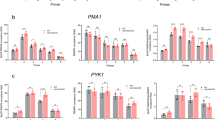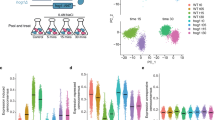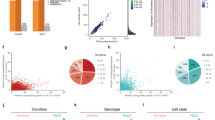Abstract
In budding yeast, the transcriptional machinery at tRNA genes naturally interferes with replication in a way that can promote chromosome breakage. Here we show that a signaling module composed of core components of the replication stress checkpoint pathway represses this fork-pausing machinery in normally cycling and genotoxin-treated cells. Specifically, the sensor kinase Mec1, the signaling adaptor Mrc1 and the transducer kinase Rad53 relay signals that globally repress tRNA gene transcription during unchallenged proliferation and under conditions of replication stress. Repressive signaling in genotoxin-treated cells requires Rad53-dependent activation of a conserved repressor of tRNA gene transcription, Maf1. Cells lacking Maf1 are sensitive to replication stress under conditions of elevated tRNA gene transcription. We propose that checkpoint control of the fork-pausing activity of tRNA genes complements the repertoire of replisome-targeted mechanisms by which checkpoint proteins promote faithful DNA replication.
This is a preview of subscription content, access via your institution
Access options
Subscribe to this journal
Receive 12 print issues and online access
$259.00 per year
only $21.58 per issue
Buy this article
- Purchase on SpringerLink
- Instant access to full article PDF
Prices may be subject to local taxes which are calculated during checkout




Similar content being viewed by others
References
Geiduschek, E.P. & Kassavetis, G.A. The RNA polymerase III transcription apparatus. J. Mol. Biol. 310, 1–26 (2001).
Deshpande, A.M. & Newlon, C.S. DNA replication fork pause sites dependent on transcription. Science 272, 1030–1033 (1996).
Ivessa, A.S. et al. The Saccharomyces cerevisiae helicase Rrm3p facilitates replication past nonhistone protein-DNA complexes. Mol. Cell 12, 1525–1536 (2003).
Azvolinsky, A., Giresi, P.G., Lieb, J.D. & Zakian, V.A. Highly transcribed RNA polymerase II genes are impediments to replication fork progression in Saccharomyces cerevisiae. Mol. Cell 34, 722–734 (2009).
Szyjka, S.J., Viggiani, C.J. & Aparicio, O.M. Mrc1 is required for normal progression of replication forks throughout chromatin in S. cerevisiae. Mol. Cell 19, 691–697 (2005).
Szilard, R.K. et al. Systematic identification of fragile sites via genome-wide location analysis of γ-H2AX. Nat. Struct. Mol. Biol. 17, 299–305 (2010).
Mohanty, B.K., Bairwa, N.K. & Bastia, D. The Tof1p-Csm3p protein complex counteracts the Rrm3p helicase to control replication termination of Saccharomyces cerevisiae. Proc. Natl. Acad. Sci. USA 103, 897–902 (2006).
Hodgson, B., Calzada, A. & Labib, K. Mrc1 and Tof1 regulate DNA replication forks in different ways during normal S phase. Mol. Biol. Cell 18, 3894–3902 (2007).
Sekedat, M.D. et al. GINS motion reveals replication fork progression is remarkably uniform throughout the yeast genome. Mol. Syst. Biol. 6, 353 (2010).
Lambert, S. & Carr, A.M. Checkpoint responses to replication fork barriers. Biochimie 87, 591–602 (2005).
Lambert, S., Froget, B. & Carr, A.M. Arrested replication fork processing: interplay between checkpoints and recombination. DNA Repair (Amst.) 6, 1042–1061 (2007).
Rothstein, R., Michel, B. & Gangloff, S. Replication fork pausing and recombination or “gimme a break”. Genes Dev. 14, 1–10 (2000).
Admire, A. et al. Cycles of chromosome instability are associated with a fragile site and are increased by defects in DNA replication and checkpoint controls in yeast. Genes Dev. 20, 159–173 (2006).
Boule, J.B. & Zakian, V.A. Roles of Pif1-like helicases in the maintenance of genomic stability. Nucleic Acids Res. 34, 4147–4153 (2006).
Azvolinsky, A., Dunaway, S., Torres, J.Z., Bessler, J.B. & Zakian, V.A. The S. cerevisiae Rrm3p DNA helicase moves with the replication fork and affects replication of all yeast chromosomes. Genes Dev. 20, 3104–3116 (2006).
de la Loza, M.C., Wellinger, R.E. & Aguilera, A. Stimulation of direct-repeat recombination by RNA polymerase III transcription. DNA Repair (Amst.) 8, 620–626 (2009).
Willis, I.M., Desai, N. & Upadhya, R. Signaling repression of transcription by RNA polymerase III in yeast. Prog. Nucleic Acid Res. Mol. Biol. 77, 323–353 (2004).
Ghavidel, A. & Schultz, M.C. TATA binding protein-associated CK2 transduces DNA damage signals to the RNA polymerase III transcriptional machinery. Cell 106, 575–584 (2001).
Wyatt, M.D. & Pittman, D.L. Methylating agents and DNA repair responses: Methylated bases and sources of strand breaks. Chem. Res. Toxicol. 19, 1580–1594 (2006).
Callegari, A.J. & Kelly, T.J. Shedding light on the DNA damage checkpoint. Cell Cycle 6, 660–666 (2007).
Harrison, J.C. & Haber, J.E. Surviving the breakup: the DNA damage checkpoint. Annu. Rev. Genet. 40, 209–235 (2006).
Alcasabas, A.A. et al. Mrc1 transduces signals of DNA replication stress to activate Rad53. Nat. Cell Biol. 3, 958–965 (2001).
Roberts, D.N., Wilson, B., Huff, J.T., Stewart, A.J. & Cairns, B.R. Dephosphorylation and genome-wide association of Maf1 with Pol III-transcribed genes during repression. Mol. Cell 22, 633–644 (2006).
Oficjalska-Pham, D. et al. General repression of RNA polymerase III transcription is triggered by protein phosphatase type 2A-mediated dephosphorylation of Maf1. Mol. Cell 22, 623–632 (2006).
Sanchez, Y. et al. Regulation of RAD53 by the ATM-like kinases MEC1 and TEL1 in yeast cell cycle checkpoint pathways. Science 271, 357–360 (1996).
Osborn, A.J. & Elledge, S.J. Mrc1 is a replication fork component whose phosphorylation in response to DNA replication stress activates Rad53. Genes Dev. 17, 1755–1767 (2003).
Katou, Y. et al. S-phase checkpoint proteins Tof1 and Mrc1 form a stable replication-pausing complex. Nature 424, 1078–1083 (2003).
Kats, E.S., Albuquerque, C.P., Zhou, H. & Kolodner, R.D. Checkpoint functions are required for normal S-phase progression in Saccharomyces cerevisiae RCAF- and CAF-I-defective mutants. Proc. Natl. Acad. Sci. USA 103, 3710–3715 (2006).
Gasch, A.P. et al. Genomic expression responses to DNA-damaging agents and the regulatory role of the yeast ATR homolog Mec1p. Mol. Biol. Cell 12, 2987–3003 (2001).
Tercero, J.A., Longhese, M.P. & Diffley, J.F. A central role for DNA replication forks in checkpoint activation and response. Mol. Cell 11, 1323–1336 (2003).
Nieduszynski, C.A., Hiraga, S., Ak, P., Benham, C.J. & Donaldson, A.D. OriDB: a DNA replication origin database. Nucleic Acids Res. 35, D40–D46 (2007).
Hartman, J.L. t. Buffering of deoxyribonucleotide pool homeostasis by threonine metabolism. Proc. Natl. Acad. Sci. USA 104, 11700–11705 (2007).
Shimada, K. et al. Ino80 chromatin remodeling complex promotes recovery of stalled replication forks. Curr. Biol. 18, 566–575 (2008).
Morrison, A.J. et al. Mec1/Tel1 phosphorylation of the INO80 chromatin remodeling complex influences DNA damage checkpoint responses. Cell 130, 499–511 (2007).
Ciesla, M. et al. Maf1 is involved in coupling carbon metabolism to RNA polymerase III transcription. Mol. Cell. Biol. 27, 7693–7702 (2007).
Parsons, A.B. et al. Exploring the mode-of-action of bioactive compounds by chemical-genetic profiling in yeast. Cell 126, 611–625 (2006).
Cabart, P., Lee, J. & Willis, I.M. Facilitated recycling protects human RNA polymerase III from repression by Maf1 in vitro. J. Biol. Chem. 283, 36108–36117 (2008).
Thompson, M., Haeusler, R.A., Good, P.D. & Engelke, D.R. Nucleolar clustering of dispersed tRNA genes. Science 302, 1399–1401 (2003).
O'Neill, B.M. et al. Pph3-Psy2 is a phosphatase complex required for Rad53 dephosphorylation and replication fork restart during recovery from DNA damage. Proc. Natl. Acad. Sci. USA 104, 9290–9295 (2007).
Krogan, N.J. et al. High-definition macromolecular composition of yeast RNA-processing complexes. Mol. Cell 13, 225–239 (2004).
Huang, Y. & Maraia, R.J. Comparison of the RNA polymerase III transcription machinery in Schizosaccharomyces pombe, Saccharomyces cerevisiae and human. Nucleic Acids Res. 29, 2675–2690 (2001).
Pluta, K. et al. Maf1p, a negative effector of RNA polymerase III in Saccharomyces cerevisiae. Mol. Cell. Biol. 21, 5031–5040 (2001).
White, R.J. RNA polymerases I and III, growth control and cancer. Nat. Rev. Mol. Cell Biol. 6, 69–78 (2005).
Demidova, A.R., Aau, M.Y., Zhuang, L. & Yu, Q. Dual regulation of Cdc25A by Chk1 and p53–ATF3 in DNA replication checkpoint control. J. Biol. Chem. 284, 4132–4139 (2009).
Crighton, D. et al. p53 represses RNA polymerase III transcription by targeting TBP and inhibiting promoter occupancy by TFIIIB. EMBO J. 22, 2810–2820 (2003).
Marshall, L., Kenneth, N.S. & White, R.J. Elevated tRNA(iMet) synthesis can drive cell proliferation and oncogenic transformation. Cell 133, 78–89 (2008).
Negrini, S., Gorgoulis, V.G. & Halazonetis, T.D. Genomic instability–an evolving hallmark of cancer. Nat. Rev. Mol. Cell Biol. 11, 220–228 (2010).
Aparicio, O., Geisberg, J.V. & Struhl, K. Chromatin immunoprecipitation for determining the association of proteins with specific genomic sequences in vivo. Curr. Protoc. Cell Biol. Chapter 17, Unit 17 7 (2004).
Acknowledgements
We are grateful to Y. Sanchez, D. Stern and I. Willis for genetic reagents. K. Robinson, D. Stuart, M. Weinfeld, M. Grenon, N. Lowndes, I. Willis, R. Moir, O. Lefebvre and L. Minard are thanked for technical advice and M. MacDonald for technical assistance. R. Wellinger, T. Weinert, P. Pasero and J. Cobb are acknowledged for helpful discussions. This work was supported by grants to M.C.S. from the National Cancer Institute of Canada (supported by the Canadian Cancer Society), the Canadian Institutes for Health Research, the Cancer Research Society and the Alberta Heritage Foundation for Medical Research (AHFMR). V.C.N. was supported by studentships from the AHFMR and the National Science and Engineering Research Council of Canada. H.E.M. was supported by a summer studentship from the AHFMR.
Author information
Authors and Affiliations
Contributions
V.C.N. generated about half of the yeast strains and performed most of the in vivo transcription experiments as well as the assays of Maf1 phosphorylation; B.W.C. generated about half the yeast strains, performed the ChIP experiments and in vivo MAF1 epistasis transcription experiments and developed the maf1Δ HU sensitivity assay; S.L.K.-C. discovered HU repression by Maf1; D.J.H. and H.E.M. provided technical assistance to V.C.N. and B.W.C.; M.C.S. conceived the project, performed the in vitro transcription experiments and wrote the manuscript.
Corresponding author
Ethics declarations
Competing interests
The authors declare no competing financial interests.
Supplementary information
Supplementary Text and Figures
Supplementary Figures 1–10, Supplementary Tables 1 and 2, Supplementary Results and Supplementary Methods (PDF 962 kb)
Rights and permissions
About this article
Cite this article
Nguyen, V., Clelland, B., Hockman, D. et al. Replication stress checkpoint signaling controls tRNA gene transcription. Nat Struct Mol Biol 17, 976–981 (2010). https://doi.org/10.1038/nsmb.1857
Received:
Accepted:
Published:
Issue date:
DOI: https://doi.org/10.1038/nsmb.1857
This article is cited by
-
Hydroxyurea and inactivation of checkpoint kinase MEC1 inhibit transcription termination and pre-mRNA cleavage at polyadenylation sites in budding yeast
Scientific Reports (2023)
-
Yeast PAF1 complex counters the pol III accumulation and replication stress on the tRNA genes
Scientific Reports (2019)
-
Transcription–replication conflicts: how they occur and how they are resolved
Nature Reviews Molecular Cell Biology (2016)
-
PP4 dephosphorylates Maf1 to couple multiple stress conditions to RNA polymerase III repression
The EMBO Journal (2012)



